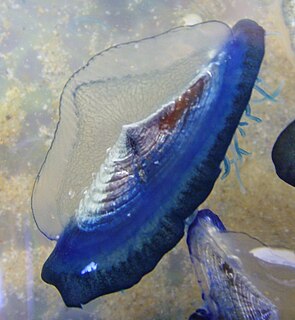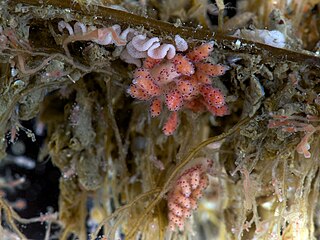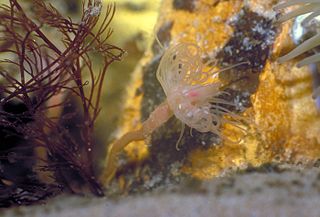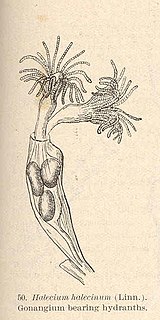
Hydrozoa are a taxonomic class of individually very small, predatory animals, some solitary and some colonial, most living in salt water. The colonies of the colonial species can be large, and in some cases the specialized individual animals cannot survive outside the colony. A few genera within this class live in fresh water. Hydrozoans are related to jellyfish and corals and belong to the phylum Cnidaria.

Velella is a monospecific genus of hydrozoa in the Porpitidae family. Its only known species is Velella velella, a cosmopolitan free-floating hydrozoan that lives on the surface of the open ocean. It is commonly known by the names sea raft, by-the-wind sailor, purple sail, little sail, or simply Velella.

Hydractinia echinata is a colonial marine hydroid which is often found growing on dead, hermit-crabbed shells of marine gastropod species. This hydroid species is also commonly known as snail fur, a name which refers to the furry appearance that the hydroids give to a shell.

Bougainvillia muscus is a marine invertebrate, a species of hydroid in the suborder Anthomedusae.
Coryne muscoides is a species of athecate hydroid belonging to the family Corynidae. It is a species of the north-eastern Atlantic Ocean and the Mediterranean Sea. This is a many-branched rose-coloured hydroid, up to 15 cm tall with distinctive ringed stems and branches. Each branch ends with a cluster of knobbed tentacles. It can be found in deep rock pools and attached to large seaweeds.

Eudendrium ramosum, sometimes known as the tree hydroid, is a marine species of cnidaria, a hydroid (Hydrozoa) in the family Eudendriidae of the order Anthoathecata.

Obelia longissima is a colonial species of hydrozoan in the order Leptomedusae. Its hydroid form grows as feathery stems resembling seaweed from a basal stolon. It is found in many temperate and cold seas world-wide but is absent from the tropics.

The tubular hydroid is a species of hydroid cnidarian, and is found in temperate coastal waters. It is a member of the family Tubulariidae.

The tubular sponge hydroid is a species of hydroid cnidarian. It is a member of the family Tubulariidae. These animals usually grow embedded in sponges.

The grey fan hydroid is a large colonial hydroid in the family Solanderiidae.

Thuiaria articulata, the jointed hydroid or sea spleenwort, is a branching colonial hydroid in the family Sertulariidae.

Gattya humilis, the snowdrop hydroid, is a delicate colonial hydroid in the family Halopterididae.

Doto sarsiae is a species of sea slug, a dendronotid nudibranch, a marine gastropod mollusc in the family Dotidae.

Ectopleura larynx, or ringed tubularia, is a hydroid in the family Tubulariidae.

Halecium muricatum, commonly known as the sea hedgehog hydroid, is a species of hydrozoan in the family Haleciidae. It occurs mainly in arctic and northern temperate waters, in both the Atlantic and Pacific Oceans.

Halecium halecinum, commonly known as the herring-bone hydroid, is a species of hydrozoan in the family Haleciidae. It is native to the eastern Atlantic Ocean, the western Atlantic Ocean and the eastern Pacific Ocean.

Obelia dichotoma is a broadly distributed, mainly marine but sometimes freshwater, colonial hydrozoan in the order Leptothecata that forms regular branching stems and a distinctive hydrotheca. O. dichotoma can be found in climates from the arctic to the tropics in protected waters such as marches and creeks but not near open coasts like beaches in depths up to 250m. O. dichotoma uses asexual and sexual reproduction and feeds on mainly zooplankton and fecal pellets. Obelia dichotoma has a complex relationship with the ecosystem and many economic systems.

Clava is a monotypic genus of hydrozoans in the family Hydractiniidae. It contains only one accepted species, Clava multicornis. Other names synonymous with Clava multicornis include Clava cornea, Clava diffusa, Clava leptostyla, Clava nodosa, Clava parasitica, Clava squamata, Coryne squamata, Hydra multicornis, and Hydra squamata. The larvae form of the species has a well developed nervous system compared to its small size. The adult form is also advanced due to its ability to stay dormant during unfavorable periods.

Dracophyllum muscoides, commonly known as Cushion inaka, is a small cushion plant in the family Ericaceae. It is endemic to New Zealand and is found only in the South Island in sub-alpine regions.


















